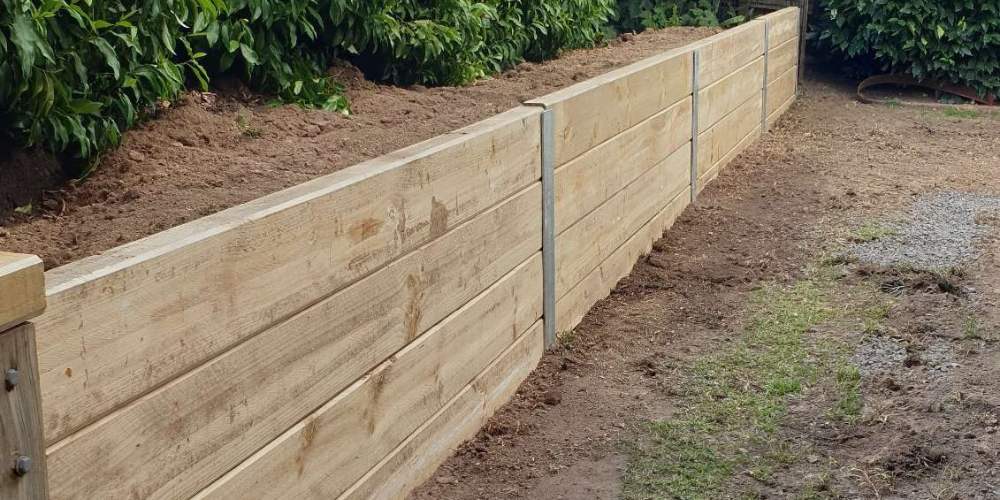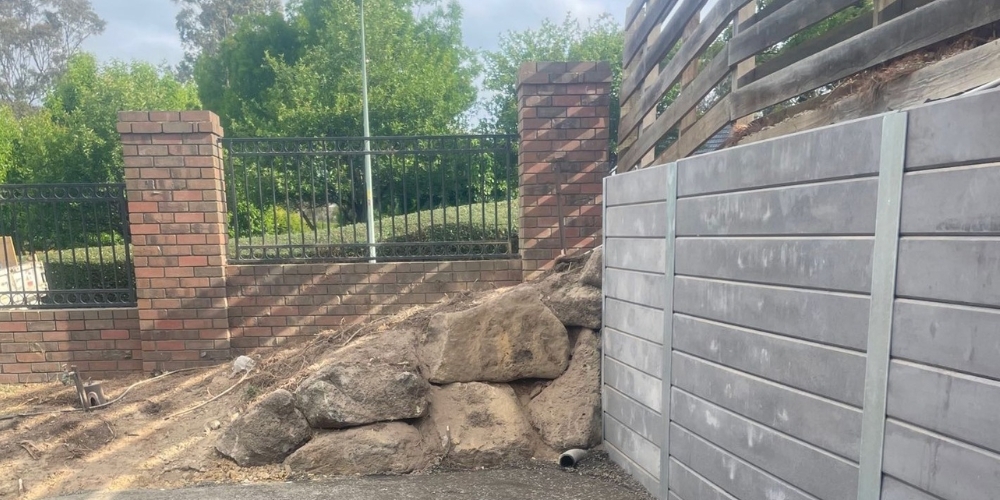10 Reasons Why Your Retaining Wall Will Fail
Retaining walls are expensive. That’s the truth. But here’s the kicker – they can also go belly up if not done right. You wouldn’t want your hard-earned money to crumble along with your wall, right?
So right before any project, we would speak to our clients heart-to-heart, trying to make them understand the importance of getting it spot-on. Because, let’s face it, a failing retaining wall is like throwing cash into a pit – not a good investment at all.
Now, I get it. Nobody likes to think about their wall giving up the ghost. But trust me, it’s better to be in the know before you see your bricks kissing the ground. Stick around as we unravel the ten reasons your retaining wall might be plotting its downfall and how you can be the hero to save it.
Let’s dive into the nitty-gritty of what makes or breaks these towering protectors of your landscape.

10 Reasons Your Retaining Wall Will Fail
Poor Drainage
Think of water as a clever ninja scheming to breach your wall while you are not looking. When it pools behind the scenes, it progressively erodes the foundation you rely on. This stealthy killer gradually erodes the foundation of your wall, setting up a dangerous scenario for a massive collapse.
Inferior Substances
While cheap may seem alluring, it frequently results in heartache in retaining walls. Cutting corners on high-quality materials is like constructing a wall on an unstable foundation of disappointment. Before you know it, the materials you were so tight on are collapsing right before your eyes, leaving you with a mess rather than a strong structure.
Wrong Design
Imagine that the burden your wall is bearing is similar to an unwanted dancing partner attempting to perform a cha-cha with a sort of soil it can’t handle. The disaster’s choreography is this mismatch in landscaping design. A retaining wall should be specifically designed for its surroundings; otherwise, problems will surely arise.
Lack of Reinforcement
Your wall requires reinforcement to stand tall, just as muscles require support to extend their strength fully. If you skip this important step, your once-sturdy barrier will become unstable and wait for the next wind gust or force to topple it.
Improper Installation
Cutting corners during installation is like playing Jenga with your wall’s stability. Each block should snugly fit into place, and the foundation must be as solid as a rock. Fail at this, and you’ve essentially set a ticking time bomb beneath your hard-earned investment.
Ignoring Professional Advice
The DIY spirit is admirable, but expertise matters when retaining walls. Ignoring the sage advice of professionals is akin to navigating treacherous waters without a map. The result? Structural failure and a repair bill that’ll have you wishing you’d listened to the experts in the first place.
Tree Roots Invasion
Though the pretty trees next to your wall may appear innocent, their roots have ulterior motives. They engage in a tug-of-war with the stability of your wall as they get bigger. Before you realise it, those seemingly innocuous roots start to undermine the structural integrity of your wall.
Earthquakes and Seismic Activity
It’s like being in a dance competition with Mother Nature when you live in an earthquake-prone location. Your retaining wall must be built to resist seismic activity and have a groove that moves with the shocks. If you overlook this important factor, your wall may unintentionally dance with the earth.
Neglecting Regular Maintenance
For your retaining wall to last, it needs attention now and then. Skipping regular checks is like ignoring your car’s oil change – eventually, things will go south. We’re talking about removing weeds, fixing small damages, and ensuring water flows where it should. It’s not rocket science, just common sense. Think of it as giving your wall a quick tune-up to prevent bigger headaches. Regular maintenance is the no-nonsense secret to keeping your retaining wall sturdy and standing strong. Don’t skip it – your wall will thank you.

Signs That Your Retaining Wall is Already Failing
Visible Leaning or Tilting
Suppose the retaining wall is tilting or leaning. In that case, that is one of the most obvious signs of a possible problem. If left untreated, this could indicate a lack of structural integrity and result in a collapse.
Cracks in the Wall
Horizontal cracks, in particular, can be an indication of issues. These cracks could be signs of pressure from the earth behind the wall, and if they are ignored, they could jeopardise the wall’s structure.
Bulging or Bowing
A bulging or bowing outward of parts of the retaining wall indicates increased pressure. This can result from bad drainage, insufficient design, or other structural problems that require quick fixing.
Water Pooling Behind the Wall
Water buildup behind the retaining wall is a serious problem. Inadequate drainage may strain the building excessively, sometimes resulting in collapse. To avoid problems with water, proper drainage is essential.
Erosion at the Base
It may indicate that water weakens the foundation if you notice soil erosion around the retaining wall’s base. As a result, the wall becomes more prone to collapsing due to weakened support. It’s critical to take immediate action to address drainage and erosion issues.
Cost To Fix a Retaining Wall
Just like estimating the cost of a new retaining wall, preparing a budget for repairing a damaged one is prudent. The extent of the damage and the specific repair requirements will naturally influence the overall expense.
In our experience, addressing a collapsed retaining wall typically costs $800 to $1000. This estimate encompasses materials, labour, and any necessary additional components. However, it’s important to note that this is a general figure, and the actual cost can vary based on factors such as the size of the wall, the materials used, and the complexity of the repair.
Tips To Prevent Retaining Wall Failure
Get a Professional Assessment
Bringing in an expert before you start creating is a wise option. They will examine your property closely, assess the soil, analyse the behaviour of water, and determine the optimal design for your retaining wall. This early examination helps catch potential concerns and ensures your wall is custom-fit to your terrain.
Select Quality Materials
Go for the best when choosing the materials for your wall. Think about the kind of soil you have, the height of your wall, and the weight that it must sustain. Choose durable materials, such as sturdy blocks and efficient reinforcements, to ensure your wall is long-lasting and strong.
Address Drainage Requirements
Remember to value the significance of appropriate drainage. Make preparations in advance to guarantee that water won’t harm your wall. Backfill with materials like gravel, then add drainage pipes to divert water. Using this technique, you may stop soil erosion and strengthen your wall’s ability to withstand water pressure without collapsing.
Follow Local Regulations
Verify the local building codes before implementing your design. Obtain the required permits and confirm that your wall-building endeavours comply with the guidelines. This assures you that your wall will remain sturdy and secure over time and guarantees that your building is safe, legal, and compliant.
Frequently Asked Questions
The quality of the structure, the materials used, and the surrounding environment all affect how long something lasts. Well-constructed walls made of sturdy materials can endure for several decades, and their lifespan can be increased with routine upkeep.
Adding decorative components to your retaining wall will improve its aesthetic appeal. Nonetheless, it is important to guarantee that these augmentations do not jeopardise the wall’s structural soundness.
Stop erosion around your retaining wall by providing adequate drainage, backfilling with gravel, and strategically placing plants. Seek expert advice to create a successful erosion control strategy.
The cost depends on factors like materials, labour, and the size of the wall. For an accurate estimate, consult a professional contractor who can assess your needs and provide a detailed cost breakdown.
Conclusion
Keeping an eye on your retaining wall is smart. Leaning, cracking, or water troubles can mean it’s not feeling so steady. Don’t wait. If you see signs of trouble, get a pro to check it out. Early fixes save big headaches later. Remember, a strong wall means a secure space. Now, inspect and keep your wall standing strong!
Contact professionals for a thorough assessment if you’re unsure or need help. They’ll guide you on the right steps to keep your retaining wall in top-notch shape. Your landscape will thank you.
